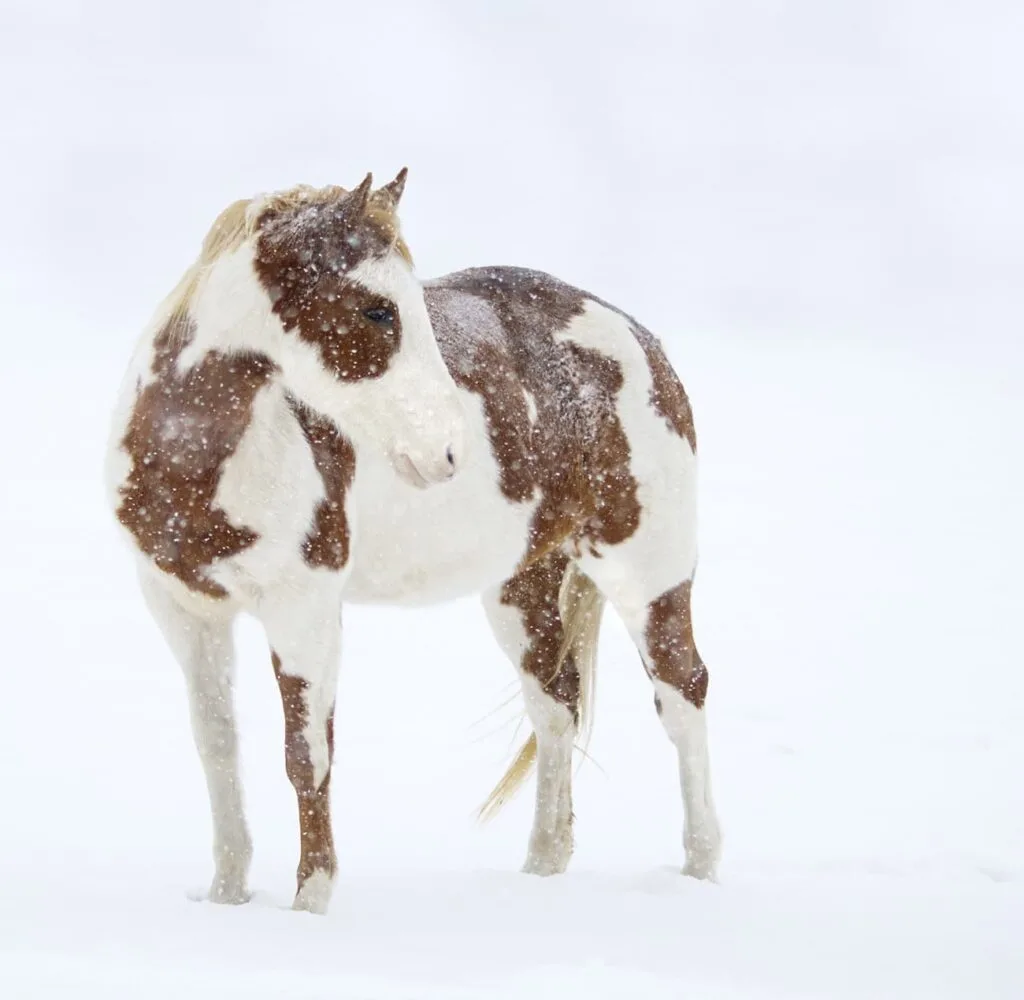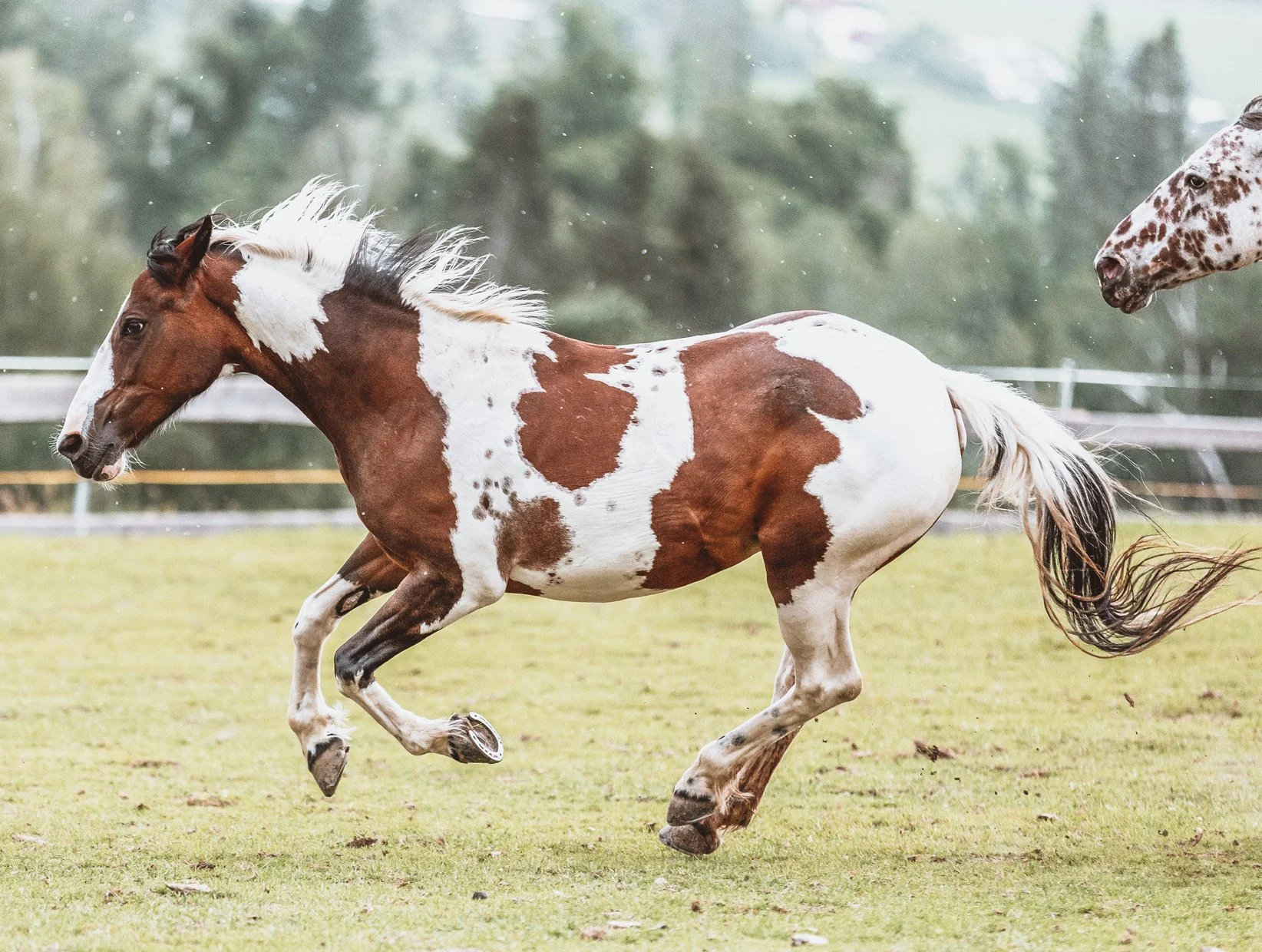A white horse with brown spots is called a leopard appaloosa or a pinto, depending on how the spots appear on the coat. White horses with very small brown spots are a type of appaloosa color, while horses with large brown spots are pintos.
White horses with brown spots can be from many breeds. These horses- like just about all colors of horses- can be excellent show horses, trail horses, ranch horses, or riding lesson mounts.
Paint/Pinto Version of Brown Spots*

Appaloosa Version of Brown Spots

Not all paint horses are pintos, and vice-versa, though the term is often used interchangeably. Read about the difference between paint and pinto horses.
Famous White Horses with Brown Spot
While there have been plenty of white (typically, technically grey) horses in the Olymics, so far, there has never been a white horse with brown spots. Japan’s rider Shino Hirota and her brown-spotted pinto “Life is Beautiful” came close to making the team for the 2020/2021 Tokyo Olympics.1

Rarity
As an expert horse breeder, I can say that white horses with brown spots, also known as Pinto horses, are not necessarily rare, but they are less common than solid-colored horses. The frequency of brown spotting in white horses depends on various factors, such as breed, genetics, and breeding practices.
In my experience, some horse breeds, such as the American Paint Horse and the Pinto Horse, are known for their spotted coats, including brown spots on white. In these breeds, horses with brown spotting are quite common. However, in other breeds, such as Thoroughbreds or Arabians, spotted coats are less common, and therefore, horses with brown spotting on a white coat may be considered rare.
Breeding for Health & Temperament First
When breeding horses, it’s essential to consider the coat color and pattern, as they can affect the horse’s value and suitability for certain disciplines. Breeders often aim to produce horses with unique and eye-catching coat patterns, including horses with brown spots on white.
It’s important to note that the genetics of coat color and pattern can be complex, and not all horses with white coats will have brown spots. However, with careful breeding practices and an understanding of the underlying genetics, some breeders do successfully breed with this color and pattern in mind.
Reputable horse breeders always strive to produce healthy, well-tempered horses – with desirable coat colors and patterns, including those with brown spots on white, as a secondary goal.

Horse Breeds featuring this Color
Horse Breeds where pinto type of this color occurs
- American Paint Horse: This breed is known for its unique coat patterns, including tobiano, overo, and tovero. These patterns can include spots of different colors, including brown, black, and white.
- Pinto Horse: This breed is often confused with the American Paint Horse, but it is a distinct breed that is also known for its spotted coat patterns. You can read more about that in our article on Paint vs Pinto names.
- Mustangs and all breeds with mustangs in their background may have white bodies and brown spots, including breeds like Morgan Horses, Tenessee Walking Horses, Rocky Mountain Horses, and Curly Horses.
Horse breeds where the appaloosa version occurs
- Appaloosa: This breed is known for its distinctive coat patterns, which include spots, speckles, and patches of various colors, including brown, black, and white.
- Knabstrupper: This breed originated in Denmark and is known for its spotted coat patterns, including leopard spots, blanket patterns, and minimal spot patterns.
- Mustangs and MOST (but not all) breeds with mustangs in their background may have appaloosa-type white bodies and brown spots, including breeds like Curly Horses, Nez Perce Horses, Colorado Ranger, and Pony of the Americas.
Genetics Behind a White horse with Brown Spots
Because, as I mentioned, appaloosa-type spots and pinto-type spots are different, they also have a different combination of genes.

Appaloosa Genetics
The gene responsible for Appaloosa markings is called the LP gene (Leopard Complex). The LP gene is a dominant gene (i.e. if present, it will be visible in some way) that produces a variety of coat patterns, including spotted blankets, leopard spots, snowflake patterns, etc. This gene modifies an existing coat color. So a horse that would have been bay, chestnut, sorrel, or even chocolate palomino may become a white horse with brown spots if one parent gives them the LP gene.
Pinto Genetics
Now, it’s a little different for pinto horses. A few genes may be behind big splotches of brown color on a white mare or gelding’s body. These genes include the tobiano gene (These horse’s spots or patches are usually well-defined, with the white fur typically crossing over the horse’s back), the Overo gene, the Sabino gene, and the Splashed White gene, all of which have subtle different expressions but often require a horse color DNA test to know for sure.2
Temperament of horses with black or brown spots
Despite what some old horse professionals in solid-color-only breed circles might say, spotted horses are not inherently “crazy” or wilder.
A horse’s behavior and temperament are influenced by a variety of factors, including genetics, upbringing, training, how they were handled as foals, and how much people did with them when they were yearlings. While some horse breeds are generally more reactive than others, this is not necessarily related to their coat color or pattern.
In fact, Appaloosas, which are known for their distinctive spotted coat patterns, are often chosen as kids’ first horses because of their generally calm and steady temperament. Many Appaloosas have been selectively bred for their gentle nature.

Prices of Spotted Horses
Depending on the breed, location, and other factors, prices vary. Horses with spots might be more expensive than a similar horse with no spots.
For example, in an area – like Oklahoma – where appaloosas are common, a white horse with brown spots may be the same price as a solid-colored quarter horse with similar training. However, if the spots are particularly eye-catching – like the leopard-colored horse featured in this article – it may cause a modest increase in price.
Sometimes, a spotted horse might cost less than a similar solid horse. For example, in riding disciplines like hunter/jumper and equitation, many riders prefer solid horses without a lot of flash. In these riding circles, a horse with loud coloring might draw attention away from the rider, which is undesirable. A spotted horse trained for these disciplines might take longer to sell – or sell at a lower price- than a similar solid-colored horse.
The exception to this pricing model, I’ve found in my years buying horses and coaching riders through purchasing their first horse, is this: Horses with spots are much more expensive when their color is both desired and rare.3
Final Thoughts
These horses are not necessarily rare, but they are less common than solid-colored horses. The frequency of brown spotting in white horses depends on various factors such as breed, genetics, and breeding practices. Breeds such as the American Paint Horse and the Pinto Horse are known for their spotted coats, while in other breeds such as Thoroughbreds or Arabians, spotted coats are less common.
The genetics of coat color and pattern can be complex, and not all horses with white coats will have brown spots.
- Life is Beautiful for Shino. 21 Jan 2019. FEI. https://www.fei.org/stories/sport/jumping/life-beautiful-shino-hirota-japan [↩]
- UC Davis Veterinary Genetics Labratory. https://vgl.ucdavis.edu/test/sabino-1 [↩]
- Freeborn, J. (2009). Hedonic price analysis of the internet recreational equine market (Doctoral dissertation, Kansas State University). https://krex.k-state.edu/handle/2097/1129 [↩]

